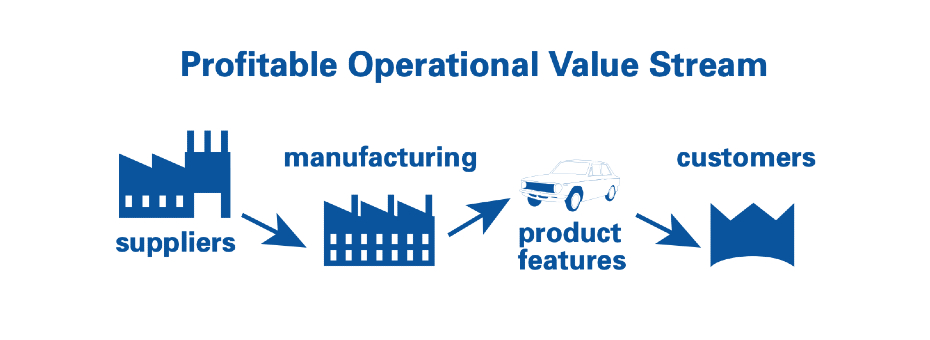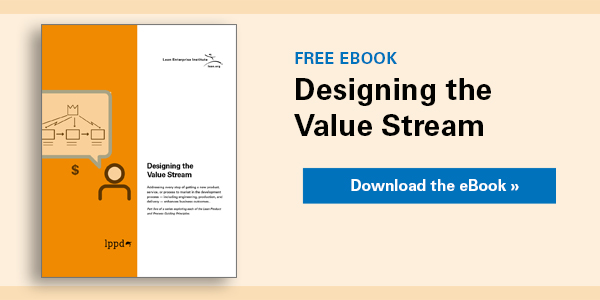“The aim of lean product development is the creation of profitable value streams.”
This statement, as simple and straightforward and even obvious as it is, is revolutionary.
We owe the insight to Allen Ward. Al, who passed away tragically in a plane crash in 2004, gave us numerous concepts foundational to lean product and process development (including even the moniker “lean product and process development”). Of them, it’s the principle that product development should aim to create profitable value streams that, more than any other, turns conventional product development entirely on its head. It’s a principle that requires organizations and the people in them to think and work differently.
Building Successful Value Streams
Engineering can do engineering alone. But it can’t do product development alone. Not if we take Al’s definition seriously: Development that creates profitable value streams must seamlessly connect and align each part of the value stream, from idea to delivery. That product development should require enterprise-wide collaboration is a concept that is neither new nor obscure. It requires no great genius to understand that it is nuts to toss product (or service) designs “over the wall” to an operational organization that is incapable of handling it. The resulting disconnects and turf wars cause unhappy customers, shareholders, and employees. And, ultimately, loss of customers, shareholders, and employees.
Yet, organizations still work in the old, siloed way. Even modest-sized organizations that develop low-complexity products still toss development work over the wall to the next silo. And then they measure and reward performance in piecemeal fashion, all but guaranteeing the whole will be less than the sum of the parts. The result is that broken value streams and failed products (and services) are, if not the norm, the inevitable result unless we exercise superhuman efforts to pull things together at the last minute. Which good, overworked people often do.
The alternative to pulling rabbits out of hats by merely working harder lies in how development work is conducted and managed. Al prodded companies to give up “scientific management” (cast as a top-down or an engineer-led process) in favor of “management by science,” in which each individual is the scientist conducting science on his or her own work.
Al provocatively argued that “development exists to create operational value streams.” Still, it’s crucial to note that the value stream concept applies to all organizations, not just those who make products. Al was speaking in a specific context: for-profit commercial enterprise. But tweak the words just a bit, replace “profitable” with “successful,” and the concept can be applied to any thing or activity that is designed or developed. For example, your local fire department need not be profitable (let’s hope profitability is not their aim!). Still, they have objectives to be met (and with prudent stewardship of resources) that require cross-functional alignment and execution. In fact, LPPD principles and practices are being applied to design clinical pathways at one (at least) major academic medical center – Michigan Medicine – where profitability is far from the primary objective. From a lean thinking perspective, any enterprise should have a defined value-driven purpose to which all products, processes, and value streams are directed – purpose, not “profit” necessarily, is the ultimate aim.
Transforming the Enterprise
As enterprises have struggled to adopt lean strategies and practices over the years, we’ve learned that product/service development may be the most leverageable activity for organizations to focus their efforts to transform. Transformations that begin in operations tend to stay in operations. Transformations that start in a corporate bureaucracy die in corporate bureaucracy. Transformational change that originates in any single silo struggles to propagate across the organization. Product development – back to Al’s definition – crosses organizational boundaries.
As an example, Proctor & Gamble Chief Research, Development & Innovation Officer Kathy Fish recognized that P&G had a healthy culture and was great at execution, but fear of failure while working inside comfortable silos prevented the company from innovating as rapidly and consistently as needed.1 So, Kathy came up with a new value proposition – provide irresistibly superior customer experience – that required the organization to stop working in silos.
Kathy decided to introduce P&G to lean innovation, with experimentation happening all the time, necessitating a crucial change in mindset: fall in love with the problem, not the solution. Unable to simply tell the business unit leaders what to do, Kathy did what she could do within her control while reaching out broadly to the organization to encourage leaders to join voluntarily. She embraced lean management concepts and practices such as focusing on the problem, asking questions that chipped away at the culture of fear, encouraging experimentation, leading through influence, breaking down silos, and embracing innovation in product development as a full team activity.
Al’s concepts echo throughout the Harvard researchers’ analysis of lean innovation at P&G1.
Moving from Disruption to Normal
The role of product development in enabling constructive yet disruptive change with stability was an essential underpinning of the most famous lean transformation: the New United Motor Manufacturing, Inc. (NUMMI) in Fremont, California. The famous part of that transformation story takes place on the factory floor, where the worst-performing workforce and factory in the entire GM/UAW system became the best — and equal to the Toyota benchmark – in only one year. Factory operational and management practices led to a dramatic turnaround in performance and culture. The same workers who had sabotaged quality and failed even to come to work one day out of five embraced a radically different way of working together as a team to produce Toyota-level quality and almost Toyota levels of productivity.
But, unseen to drive-by observers was teamwork at higher organizational levels that laid the groundwork for stable, trusting work relationships and gave the factory a product that was easy to build productively and with high levels of quality. Compared to products built when GM ran the plant, the NUMMI-produced Chevrolet Nova, a rebadged Toyota Corolla, practically snapped together. Needed parts were always where they were needed when line workers required them. Equipment worked as designed. Previously, GM Fremont had to produce 116 body styles with dozens of powertrain combinations and an unlimited options list. NUMMI produced one body style with six option packages when it shipped its first products in 1985.
As it turned out, that Chevy Nova didn’t sell well. The value stream wasn’t profitable. Customers simply didn’t buy the product. Ouch. Traditionally, GM would’ve shuttered the program. Instead, Toyota began introducing a series of new products to the plant, steadily increasing the complexity NUMMI was tasked to handle as it gained capability.
Flash forward from Fremont, California, circa 1985, to Normal, Illinois, today. There, Rivian Automotive (full disclosure, I have a relationship with the company) is gearing up to ship its first vehicles to customers later this month, an electric pickup truck that is, in many respects, the most capable vehicle ever offered. The pickup can accelerate from 0 to 60 in 3.0 seconds (faster than a new Ferrari Portofino), crawl over rocks with an 11-inch ground clearance (more than a new Jeep Wrangler), handle on the track like a quattro-equipped Audi, all with the ride comfort of a Lexus luxury sedan, except even quieter. Incredible. Following a recent test drive on the track and off-road, I can personally attest to the remarkable performance of the vehicle — but a remarkable product does not necessarily equate to a profitable value stream.
Proof of success for Rivian, as for each of the many new auto companies, will come not just from amazing product design. For the companies to be successful, their value streams must be successful (profitable). That means that the value stream’s product and processes are developed concurrently to address customer needs; components are developed and sourced in partnership with capable suppliers and delivered as needed; and sales and service operations enhance the overall customer experience. We can all observe together whether Rivian – or any other startup in the auto and other industries – leverages management by science and creates successful, profitable value streams.
Innovating at the Value-Stream Level
“The aim of product development is the creation of profitable (successful) value streams.” Is Rivian’s? Time will tell. Is yours? You can tell. But don’t wait to learn about it from your next P&L statement. Instead, take a look at your development process with a total value stream perspective.
1 Truelove, Emily, Hill, Linda A., and Tedards, Emily. July 2020. “Proctor & Gamble: Navigating Industry Disruption by Disrupting from Within.” Cambridge, MA: Harvard Business Review







